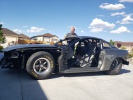I've been playing around with and reading everything I could find on tuning since purchasing my own copy of the software last fall. Now that the good weather is here and the car is out of storage, I've started trying to get a little more performance out of it. The motor is a 2000 LQ4 out of a Silverado 2500 still mated to the original 4L80E. The 873 cast iron heads have been swapped for 853's mostly as a weight saving measure, exhaust is 2 1/2 inch with straight through mufflers, no cats. The entire package is swapped into a '55 Belair - no that it makes a difference. My original tune was done by a local guy (delete VATS, EGR, Evap) regular swap stuff but no performance enhancements.
As a first step, I thought I would make changes to PE to allow it to come in earlier so I changed Delay RPM to 1400, and zeroed out the time delay. I then changed both the hot and cold throttle tables to 25% across the board. When I tried a scan with this new setup, the car didn't seem to make any more power than it did with PE disabled. I note that the AFR does go down to ~12.5 under WOT but that I also get a KR of 8*. I put the old tune back in. Since I'm brand new at this, I thought I'd post a scan of both tunes so that hopefully someone can set me on the right path. I'm guessing I have lots more reading ahead of me. I also posted the original tune if that can shed light on things. Thanks
With PE.hpl
Without PE.hpl
2019-05-13 (tow Mode enable).hpt




 Reply With Quote
Reply With Quote

